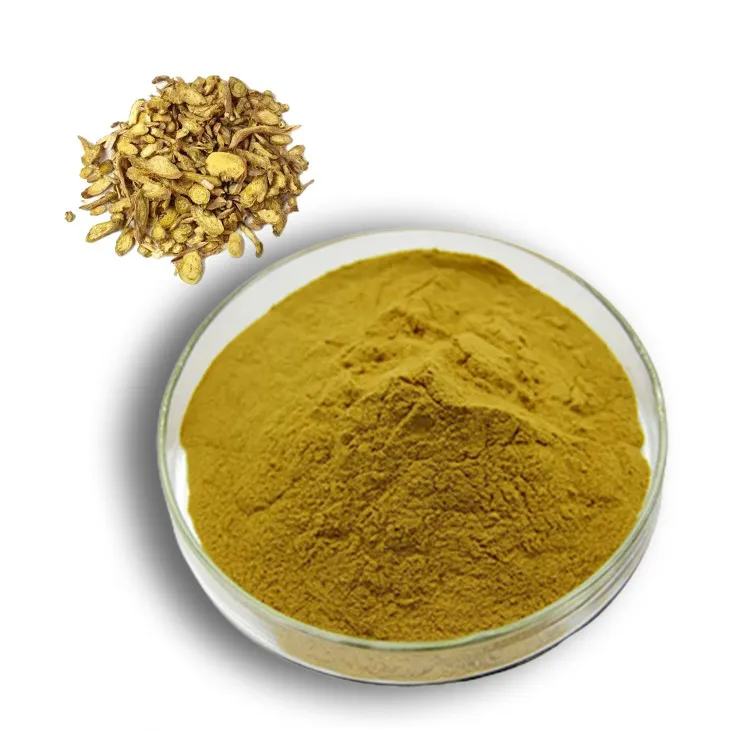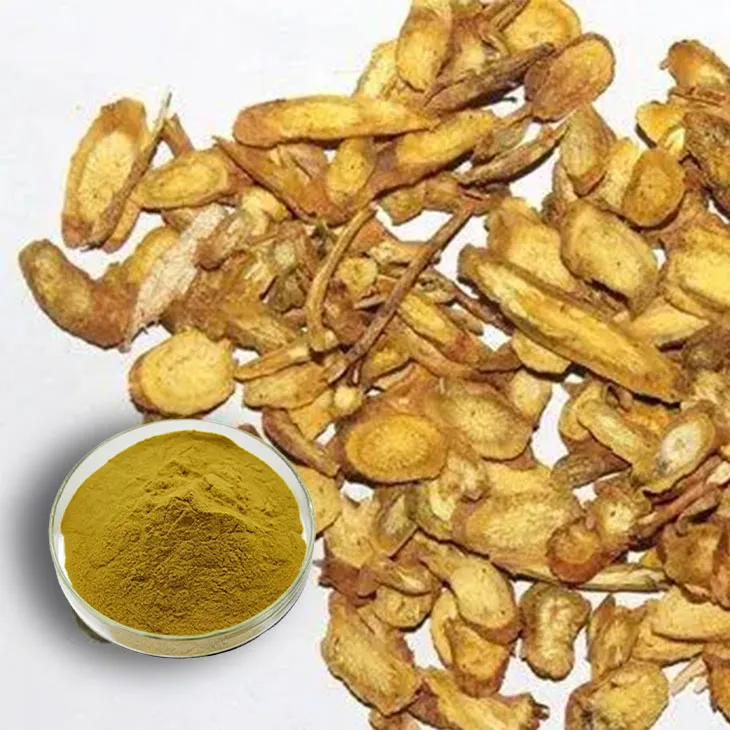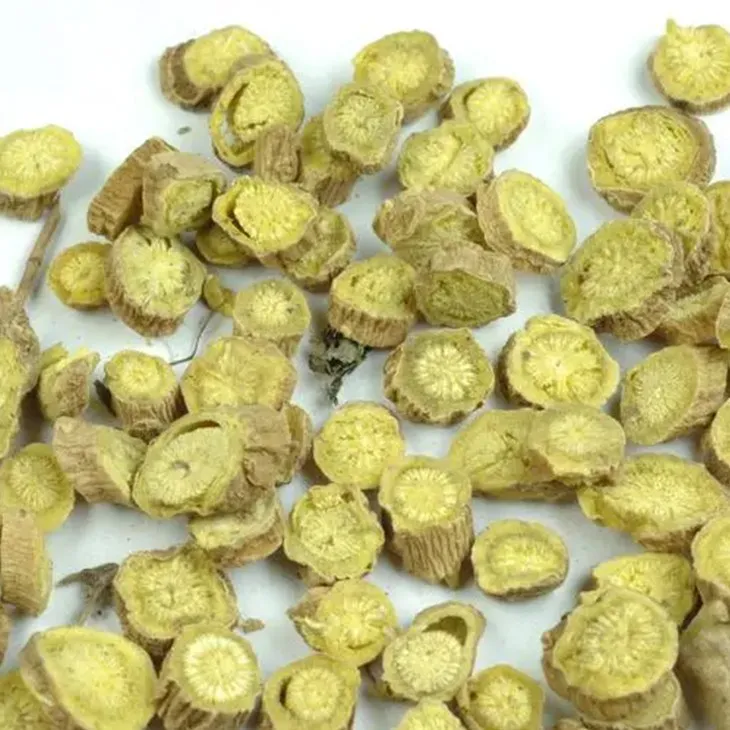- 0086-571-85302990
- sales@greenskybio.com
Optimal Bioavailability of Baicalin.
2024-11-28

1. Introduction
Baicalin, a flavonoid compound derived from Scutellaria baicalensis Georgi, has been the focus of extensive research in recent years. Its potential pharmacological activities, including anti - inflammatory, antioxidant, and anticancer properties, have made it a promising candidate for therapeutic applications. However, the bioavailability of Baicalin is a crucial factor that determines its effectiveness in vivo. Bioavailability refers to the fraction of an administered drug that reaches the systemic circulation and is available at the site of action. Understanding and optimizing the bioavailability of Baicalin is essential for maximizing its therapeutic potential.

2. Chemical Structure and Bioavailability
The chemical structure of baicalin plays a significant role in its bioavailability. Baicalin is a glycoside compound, consisting of a flavone aglycone (baicalein) and a glucuronide moiety. The presence of the glucuronide group affects its solubility and permeability, which are key determinants of bioavailability.
2.1 Solubility
Baicalin has relatively low solubility in water, which can limit its absorption. The hydrophilic nature of the glucuronide group makes it difficult for baicalin to dissolve in lipid - rich environments, such as cell membranes. Modifications in its chemical structure, such as esterification or methylation of the glucuronide group, may enhance its solubility and thus improve its bioavailability. For example, some studies have shown that ester - modified baicalin derivatives have increased solubility in both water and lipid solvents, leading to better absorption.
2.2 Permeability
The large molecular size and polar nature of baicalin due to its chemical structure pose challenges to its permeability across biological membranes. Cell membranes are composed of lipid bilayers, and substances with high lipid solubility tend to cross these membranes more easily. Baicalin, being a polar compound, may require the assistance of specific transporters or mechanisms to cross cell membranes. Some research has suggested that certain membrane proteins, such as organic anion - transporting polypeptides (OATPs), may be involved in the transport of baicalin across cell membranes. Understanding the relationship between baicalin's chemical structure and membrane permeability can help in the design of strategies to enhance its bioavailability, such as the development of prodrugs or the use of permeability - enhancing agents.

3. Route of Administration and Bioavailability
The route of administration is another important factor influencing the bioavailability of baicalin.
3.1 Oral Administration
Oral administration is the most common and convenient route for drug delivery. However, when it comes to baicalin, there are several challenges associated with oral bioavailability.
- First - pass metabolism: After oral ingestion, baicalin is absorbed in the gastrointestinal tract and then transported to the liver via the portal vein. In the liver, it undergoes extensive first - pass metabolism, which can significantly reduce the amount of baicalin reaching the systemic circulation. Enzymes in the liver, such as UDP - glucuronosyltransferases (UGTs), can conjugate baicalin, further modifying its chemical structure and potentially reducing its bioactivity.
- Gastrointestinal absorption: The low solubility and permeability of baicalin in the gastrointestinal tract can also limit its oral absorption. The acidic environment in the stomach and the presence of various digestive enzymes can affect the stability of baicalin. Moreover, the complex composition of the gut microbiota can interact with baicalin, either enhancing or inhibiting its absorption.
3.2 Intravenous Administration
Intravenous administration bypasses the first - pass metabolism in the liver and the absorption barriers in the gastrointestinal tract. This route ensures that the entire dose of baicalin is directly introduced into the systemic circulation, resulting in high bioavailability. However, intravenous administration also has its drawbacks, such as the need for specialized medical facilities and trained personnel, and the potential for adverse reactions related to the injection process, such as phlebitis or embolism.
3.3 Transdermal Administration
Transdermal administration offers an alternative way to deliver baicalin. The skin acts as a natural barrier, but certain techniques and formulations can be used to enhance the permeation of baicalin through the skin. For example, the use of penetration enhancers, such as terpenes or fatty acids, can disrupt the lipid structure of the stratum corneum, the outermost layer of the skin, and increase the permeability of baicalin. Transdermal administration has the advantage of providing a sustained release of the drug, avoiding first - pass metabolism, and being non - invasive. However, the amount of baicalin that can be delivered through the skin is relatively limited, and the development of effective transdermal formulations remains a challenge.

4. Influence of Other Substances on Baicalin's Bioavailability
The presence of other substances can have a significant impact on the bioavailability of baicalin.
4.1 Co - administration with Inhibitors of Efflux Transporters
Efflux transporters, such as P - glycoprotein (P - gp), are membrane proteins that can pump drugs out of cells, reducing their intracellular concentration and thus their bioavailability. Some substances have been identified as inhibitors of P - gp and other efflux transporters. Co - administration of baicalin with these inhibitors may increase its absorption by preventing its efflux from cells. For example, certain natural compounds like Curcumin have been shown to inhibit P - gp activity. When baicalin is co - administered with Curcumin, it may have a higher chance of being retained within cells and reaching the systemic circulation, thereby enhancing its bioavailability.
4.2 Interaction with Dietary Components
Dietary components can also interact with baicalin and affect its bioavailability.
- Fiber: High - fiber diets can affect the absorption of baicalin. Fiber can bind to baicalin in the gastrointestinal tract, reducing its availability for absorption. On the other hand, some types of fiber may also slow down the transit time in the gut, allowing for more time for baicalin to be absorbed.
- Fat: Dietary fat can influence the solubility and absorption of baicalin. Since baicalin has low lipid solubility, the presence of fat in the diet may enhance its absorption by providing a more favorable environment for dissolution. However, excessive fat intake may also lead to changes in lipid metabolism and potentially affect the overall pharmacokinetics of baicalin.

5. Strategies to Optimize Baicalin's Bioavailability
Based on the understanding of the factors affecting baicalin's bioavailability, several strategies can be employed to optimize it.
5.1 Structural Modifications
As mentioned earlier, modifications in the chemical structure of baicalin can enhance its solubility and permeability. Chemical synthesis or biotransformation methods can be used to produce baicalin derivatives with improved bioavailability properties. For example, the synthesis of ester - or methyl - modified baicalin derivatives has shown promising results in pre - clinical studies. These derivatives may have better solubility, permeability, and resistance to metabolism, leading to higher bioavailability.
5.2 Selection of Appropriate Route of Administration
The choice of the route of administration should be based on the specific requirements of the treatment and the characteristics of baicalin. For situations where rapid onset of action is required and high bioavailability is crucial, intravenous administration may be the preferred option. For long - term treatment or for patients who cannot tolerate injection, transdermal or oral formulations with improved bioavailability can be explored. Oral formulations can be optimized by using techniques such as nano - encapsulation or solid dispersion to improve the solubility and stability of baicalin in the gastrointestinal tract.
5.3 Co - administration with Bioavailability - Enhancing Agents
Co - administration with substances that can enhance baicalin's bioavailability, such as efflux transporter inhibitors or absorption enhancers, can be a viable strategy. This approach requires a thorough understanding of the pharmacokinetic and pharmacodynamic interactions between baicalin and the co - administered agents to ensure safety and effectiveness. For example, when co - administering baicalin with a P - gp inhibitor, careful monitoring of drug levels and potential side effects is necessary.
6. Conclusion
Optimizing the bioavailability of baicalin is a complex but essential task for maximizing its therapeutic potential. The chemical structure of baicalin, the route of administration, and the presence of other substances all play important roles in determining its bioavailability. By understanding these factors and implementing appropriate strategies, such as structural modifications, selection of the right route of administration, and co - administration with bioavailability - enhancing agents, it is possible to improve the bioavailability of baicalin and thus enhance its effectiveness in treating various diseases. Future research should continue to explore new methods and technologies to further optimize the bioavailability of baicalin and unlock its full therapeutic potential.
FAQ:
Question 1: How does the chemical structure of baicalin influence its bioavailability?
The chemical structure of baicalin affects its solubility and permeability. A well - designed structural modification might improve its capacity to cross biological membranes, which in turn can enhance its bioavailability. Solubility is important as it determines how well the compound can dissolve in the body fluids, and permeability is crucial for its ability to pass through cell membranes to reach the systemic circulation.
Question 2: What are the challenges of oral administration of baicalin in terms of bioavailability?
Oral administration of baicalin is common. However, it faces challenges like first - pass metabolism in the liver. During first - pass metabolism, a significant portion of the drug may be metabolized before it reaches the systemic circulation, thus reducing the amount of the active compound available for therapeutic effects, which in turn affects its bioavailability.
Question 3: How can alternative routes of administration improve the bioavailability of baicalin?
Alternative routes such as intravenous or transdermal administration may offer different bioavailability profiles. Intravenous administration bypasses the first - pass metabolism in the liver, directly delivering the drug into the bloodstream, thus potentially increasing the bioavailability. Transdermal administration allows for a slow and sustained release of the drug, which may also lead to improved bioavailability compared to oral administration.
Question 4: What types of other substances can increase baicalin's bioavailability?
Some substances that can influence baicalin's bioavailability are those that inhibit efflux transporters. When co - administered with these agents, they can increase the absorption of baicalin. This is because efflux transporters usually work to pump substances out of cells, and inhibiting them can keep baicalin inside the cells for better absorption and ultimately improved bioavailability.
Question 5: Why is understanding the factors affecting baicalin's bioavailability important?
Understanding these factors is essential for maximizing the therapeutic potential of baicalin. By knowing how the chemical structure, route of administration, and co - administered substances affect its bioavailability, researchers can develop strategies to optimize the delivery of baicalin. This can lead to more effective treatment using baicalin, ensuring that an adequate amount of the active compound reaches the site of action.
Related literature
- Bioavailability of Flavonoids: A Review of Their Membrane Transport and the Influence of Food Matrix"
- "The Pharmacokinetics of Baicalin: A Comprehensive Study"
- "Enhancing Bioavailability of Phytochemicals: Strategies and Implications"
- ▶ Hesperidin
- ▶ Citrus Bioflavonoids
- ▶ Plant Extract
- ▶ lycopene
- ▶ Diosmin
- ▶ Grape seed extract
- ▶ Sea buckthorn Juice Powder
- ▶ Fruit Juice Powder
- ▶ Hops Extract
- ▶ Artichoke Extract
- ▶ Mushroom extract
- ▶ Astaxanthin
- ▶ Green Tea Extract
- ▶ Curcumin
- ▶ Horse Chestnut Extract
- ▶ Other Product
- ▶ Boswellia Serrata Extract
- ▶ Resveratrol
- ▶ Marigold Extract
- ▶ Grape Leaf Extract
- ▶ New Product
- ▶ Aminolevulinic acid
- ▶ Cranberry Extract
- ▶ Red Yeast Rice
- ▶ Red Wine Extract
-
Konjac Powder
2024-11-28
-
Citrus Aurantium Extract
2024-11-28
-
Purple Sweet Potato Extract
2024-11-28
-
Curcuma Longa Extract/Turmeric extract
2024-11-28
-
Green Tea Extract
2024-11-28
-
Aminolevulinic acid
2024-11-28
-
Panax Ginseng Leaf Extract
2024-11-28
-
Hops Extract
2024-11-28
-
White mustard seed extract
2024-11-28
-
Lemon Juice Powder
2024-11-28





















